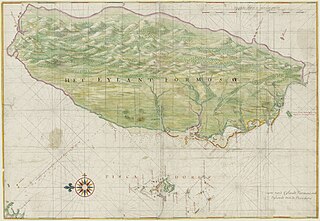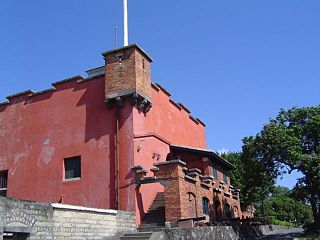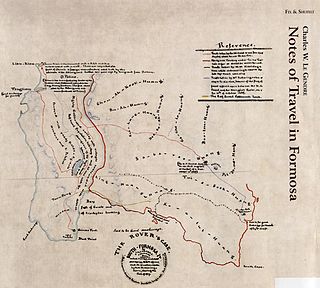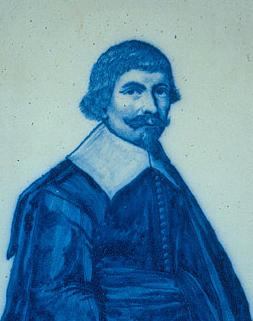
The history of the island of Taiwan dates back tens of thousands of years to the earliest known evidence of human habitation. The sudden appearance of a culture based on agriculture around 3000 BC is believed to reflect the arrival of the ancestors of today's Taiwanese indigenous peoples. Han Chinese gradually came into contact with Taiwan starting in the late 13th century and started settling there by the early 17th century. Named Formosa by Portuguese explorers, the south of the island was colonized by the Dutch in the 17th century whilst the Spanish built a settlement in the north which lasted until 1642. These European settlements were followed by an influx of Hoklo and Hakka immigrants from Fujian and Guangdong.

Taiwanese indigenous peoples, also known as Formosans, Native Taiwanese, Austronesian Taiwanese or Gaoshan people, and formerly as Taiwanese aborigines, are the indigenous peoples of Taiwan, with the nationally recognized subgroups numbering about 569,000 or 2.38% of the island's population. This total is increased to more than 800,000 if the indigenous peoples of the plains in Taiwan are included, pending future official recognition. When including those of mixed ancestry, such a number is possibly more than a million. Academic research suggests that their ancestors have been living on Taiwan for approximately 6,500 years. A wide body of evidence suggests that the Taiwanese indigenous peoples had maintained regular trade networks with numerous regional cultures of Southeast Asia before the Han Chinese colonists began settling on the island from the 17th century, at the behest of the Dutch colonial administration and later by successive governments towards the 20th century.

Fort Santo Domingo is a historical fortress in Tamsui District, New Taipei City, Taiwan. It was originally a wooden fort built in 1628 by the Spanish Empire, who named it "Fort Santo Domingo". However, the fort was then destroyed by the Spanish themselves, after losing the Second Battle of San Salvador to the Dutch Empire in 1642. After the battle, in 1644, the Dutch rebuilt a fort in the original site and renamed it "Fort Antonio". Since the Dutch were called "Red-haired People" by the Han immigrants during the time, the fort was then nicknamed "Fort Red Hair".(Chinese: 紅毛城; Pe̍h-ōe-jī: Âng-mn̂g-siâⁿ; lit. 'ang mo fort').

The Rover Incident occurred on 12 March 1867 when the American merchant ship Rover, captained by Joseph Hunt who was accompanied by his wife Mercy G. Beerman Hunt, and en route from Shantou to Niuzhuang, was wrecked off the coast of Taiwan, then ruled by the Qing dynasty. The ship struck a coral reef called Qixingyan near Cape Eluanbi and drifted into the area of Kenting in modern-day Hengchun, Pingtung County, Taiwan. Fourteen American sailors, including Hunt and his wife, were killed by Taiwanese Aborigines in revenge for earlier killings of Kaolut (Koalut/Ku-a-lut/etc) tribe members by foreigners. Subsequently, the U.S. military decided to send a military expedition against the tribe members responsible.

The island of Taiwan, also commonly known as Formosa, was partly under colonial rule by the Dutch Republic from 1624 to 1662 and from 1664 to 1668. In the context of the Age of Discovery, the Dutch East India Company established its presence on Formosa to trade with the Ming Empire in neighbouring China and Tokugawa shogunate in Japan, and also to interdict Portuguese and Spanish trade and colonial activities in East Asia.

Pieter Nuyts or Nuijts was a Dutch explorer, diplomat and politician.

The Qing dynasty ruled over the island of Taiwan from 1683 to 1895. The Qing dynasty sent an army led by general Shi Lang and defeated the Ming loyalist Kingdom of Tungning in 1683. Taiwan was then formally annexed in April 1684.

The siege of Fort Zeelandia of 1661–1662 ended the Dutch East India Company's rule over Taiwan and began the Kingdom of Tungning's rule over the island.

The cultural history of Taiwan can be traced back to prehistoric Stone Age. Later the development of written languages made it easier to maintain traditions of the Taiwanese culture.
Paulus Traudenius was the Dutch Governor of Formosa from 1640 to 1643.

Robert Junius, also recorded as Robertus Junius was a Dutch Reformed Church missionary to Taiwan from 1629 to 1643. Along with Antonius Hambroek and Joannes Cruyf, he was among the longest-serving missionaries of the Dutch colonial era in Formosa.

The Guo Huaiyi rebellion was a peasant revolt by Chinese farmers against Dutch rule in Taiwan in 1652. Sparked by dissatisfaction with heavy Dutch taxation on them but not the aborigines and extortion by low-ranking Dutch officials and servicemen, the rebellion initially gained ground before being crushed by a coalition of Dutch soldiers and their aboriginal allies. It is considered the most important uprising against the Dutch during the 37-year period of their colonisation of Taiwan.

Spanish Formosa was a small colony of the Spanish Empire established in the northern tip of the island known to Europeans at the time as Formosa or to Spaniards as "Isla Hermosa" from 1626 to 1642. It was ceded to the Dutch Republic during the Eighty Years' War.

The Battles of La Naval de Manila or Battle of Manila Bay were a series of five naval battles fought in the waters of the Spanish East Indies in the year 1646, in which the forces of the Spanish Empire repelled various attempts by forces of the Dutch Republic to invade Manila, during the Eighty Years' War. The Spanish forces, which included many native volunteers, consisted of two, and later, three Manila galleons, a galley and four brigantines. They neutralized a Dutch fleet of nineteen warships, divided into three separate squadrons. Heavy damage was inflicted upon the Dutch squadrons by the Spanish forces, forcing the Dutch to abandon their invasion of the Philippines.

Tamsui District is a seaside district in New Taipei City, Taiwan adjacent to the Tamsui River and overlooking the Taiwan Strait. The name of the district means "fresh water" in Chinese. Although modest in size, Tamsui plays a significant role in Taiwanese history and culture.
A series of military actions and diplomatic moves were undertaken in 1635 and 1636 by the Dutch East India Company (VOC) in Dutch-era Taiwan (Formosa) aimed at subduing hostile aboriginal villages in the southwestern region of the island. Prior to the campaign the Dutch had been in Formosa for eleven years, but did not control much of the island beyond their principal fortress at Tayouan, and an alliance with the town of Sinkan. The other aboriginal villages in the area conducted numerous attacks on the Dutch and their allies, with the chief belligerents being the village of Mattau, who in 1629 ambushed and slaughtered a group of sixty Dutch soldiers.

The Spanish expedition to Formosa was a campaign mounted by the Spanish based in Manila, Philippines in 1626. It was the Spanish response to Dutch settlements being built in Formosa, now known as Taiwan. In cooperation with the Portuguese, this venture was made to attract Chinese traders and curtail the expansion of Dutch power in Asia.

A Landdag was a political ceremony staged regularly by Dutch East India Company (VOC) authorities during the period of Dutch rule of Taiwan, known then as Formosa. This mass gathering of Dutch colonists and their aboriginal Formosan subjects was conceived as a device through which the Dutch, by means of a calculated display of power, prestige and paternal largesse, sought to cement their authority and the legitimacy of their rule over the native population. The Dutch word Landdag, sometimes also called rijksdag on Dutch Formosa, is roughly equivalent to the English word Diet.
The Battle of San Salvador (1642), also known as the Second Battle of San Salvador, was a military assault launched by the Dutch on a small fortified Spanish settlement and its aboriginal allies in northern Formosa 1642. After six days, the battle ended in defeat for the Spanish. The Spanish defeat secured complete island control for the Dutch.

The military history of Taiwan spans at least 400 years and is the history of battles and armed actions that took place in Taiwan and its surrounding islands. The island was the base of Chinese pirates who came into conflict with the Ming dynasty during the 16th century. From 1624 to 1662, Taiwan was the base of Dutch and Spanish colonies. The era of European colonization ended when a Ming general named Koxinga retreated to Taiwan as a result of the Ming-Qing War and ousted the Dutch in 1661. The Dutch held out in northern Taiwan until 1668 when they left due to indigenous resistance. Koxinga's dynasty ruled southwestern Taiwan as the Kingdom of Tungning and attacked the Qing dynasty during the Revolt of the Three Feudatories (1673-1681).















